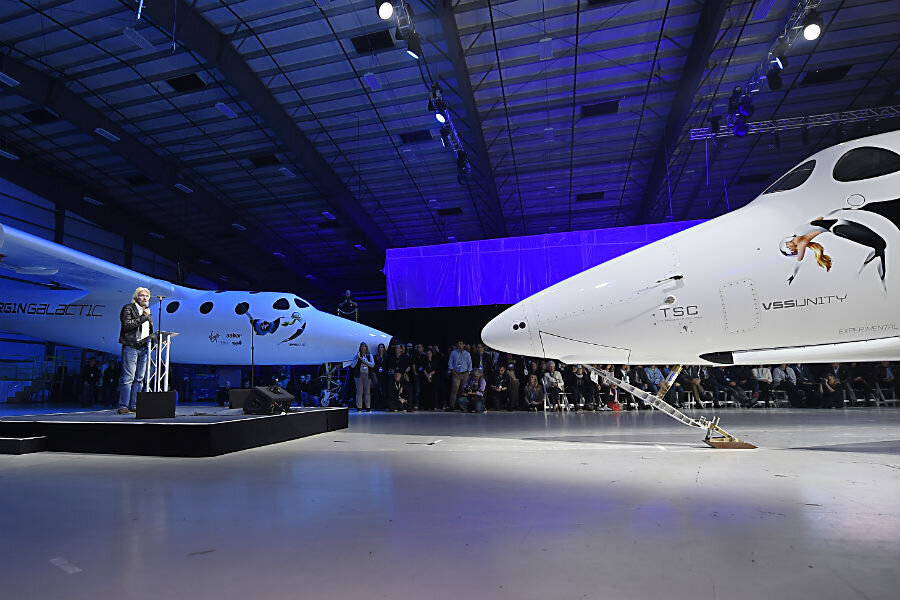Why Stephen Hawking wants to ride Virgin Galactic space ship
Loading...
| Mojave, Calif.
Richard Branson's Virgin Galactic venture unveiled a new passenger spacecraft on Friday, nearly 16 months after a fatal accident destroyed its sister ship during a test flight over California's Mojave Desert.
The rollout of the gleaming craft, dubbed Virgin Space Ship Unity, marks Branson's return to a race among rival billionaire entrepreneurs to develop a vehicle that can take thrill-seekers, researchers and commercial customers on short hops into space.
"It's almost too good to be true," Branson said during a ceremony at the Mojave Air and Space Port, about 100 miles (160 km) north of Los Angeles. "When I saw it for the first time, it brought an immediate lump to my throat and tears to my eyes. It was a completely overwhelming moment."
Christened with a bottle of milk by Branson's year-old granddaughter, the ship was painted bright white on its front section, fading to gray and black toward the tail.
The tail itself was emblazoned with a blue image of a peering eye belonging to famed British physicist Stephen Hawking.
Branson has already offered a flight into space to Hawking, who is confined to a wheelchair and is diagnosed with amyotrophic lateral sclerosis, or ALS. It was Hawking who suggested naming the ship Unity.
"I have always dreamed of spaceflight, but for so many years I thought it was just that - a dream," Hawking said in a recorded message played at the space port. "If I am able to go, and if Richard will still take me, I will be proud to fly on this spaceship."
Space.com reported that Hawking's 4-minute recorded message also included:
"We are entering a new space age, and I hope this will help to create a new unity. Space exploration has already been a great unifier — we seem able to cooperate between nations in space in a way we can only envy on Earth," Hawking said in the message.
"Taking more and more passengers out into space will enable them and us to look both outwards and back, but with a fresh perspective in both directions," he added. "It will help bring new meaning to our place on Earth and to our responsibilities as its stewards, and it will help us to recognize our place and our future in the cosmos — which is where I believe our ultimate destiny lies."
Hawking's message concluded with the name annoucement: "Please welcome Virgin Spaceship Unity."
From outward appearances, the spacecraft is nearly identical to the one lost on Oct. 31, 2014. The accident was blamed on pilot error and oversights by Northrop Gumman Corp's Scaled Composites division, which designed, built and tested the vehicle, known as SpaceShipTwo.
Virgin Galactic's own manufacturing arm, The Spaceship Company, already was well into construction of the successor ship when the accident occurred.
The original SpaceShipTwo crashed over a year ago, killing co-pilot Michael Alsbury and leaving pilot Peter Siebold badly injured. Although investigators eventually determined that Mr. Alsbury had accidentally activated the vehicle’s feathering mechanism too early, causing the craft to crash.
"Space is hard, and today was a tough day," said Virgin Galactic CEO George Whitesides during a news conference after the 2014 crash. "We are going to be supporting the investigation as we figure out what happened today, and we're going to get through it."
The biggest difference between the two is the addition of a pin to prevent a pilot from unlocking the ship's rotating tail section too soon before descent, which is what triggered the breakup of the first spaceship, said Galactic Chief Executive George Whitesides.
The two-pilot, six-passenger spaceship is designed to reach altitudes of 62 miles (100 km) above the planet, providing a few minutes of weightlessness and a view of Earth set against the blackness of space. Nearly 700 people have signed up for rides, which cost $250,000 each.
Other changes include a device to prevent pilots from releasing the ship's landing gear too early and new control switches to make them more distinct.
Friday's unveiling set the stage for Unity's first round of test flights. The company has declined to discuss a schedule, but Whitesides said he expects to rapidly repeat milestones the first craft achieved and then incrementally test the new ship at higher speeds and altitudes. The first spaceship had not yet traveled beyond the atmosphere.
Virgin Galactic is among a handful of companies, including Elon Musk's SpaceX, Jeff Bezos' Blue Origin, Paul Allen's Stratolaunch Systems and Boeing, planning to fly people in space.
Building a vehicle that can safely carry humans to the weightless heights beyond Earth's upper atmosphere is a feat so far achieved only by NASA, Russia, China and Scaled Composites, which designed and flew Virgin Galactic's prototype craft, SpaceShipOne.
Three suborbital hops by SpaceShipOne in 2004 earned it the $10 million Ansari XPrize. (Reporting by Irene Klotz; Editing by Steve Gorman and Tom Brown)







